Choosing the quietest 4000 watt generator is a sensible option no matter where you plan to use it. After all, who wants to deal with a deafening generator whether they’re camping or working on a jobsite?
So, in this article, I’ll review my top picks for the best 4000W inverter generator. Before we jump into the list, let’s look at whether a 4000W generator is the right option for you.
For different power output, check out my other related articles:
- My review of the best quiet 5000-watt generators.
- My review of the best quiet 7000-watt generators.
- My review of the best quiet 10000-watt generators
- My review of the best generators per usage scenario.
Is a 4000 Watt Generator the Right Fit for Me?
A 4000 watt generator is powerful enough to run most electronics on a campsite or in an RV. Alternatively, you could run a few power tools off a single 4000W generator. However, it’s not powerful enough to act as a backup for a home in a power outage. For that, you’d want something like a 10,000W generator.
Typically, a 4000W portable generator is fairly versatile and could power, for example:
- A toaster
- A refrigerator
- A laptop
- Lighting
It’s best suited as a reliable power source for camping thanks to its compact size and decent power delivery. While you could run a 2000W generator on a campsite, a 4000 watt one could be your only generator for all kinds of needs.
Calculating Power Demands
Of course, the easiest way to know whether a 4000 watt generator is suitable is to calculate the power demands of your setup. The first step is to understand the difference between running watts and starting watts.
- Running watts is a device’s consistent power consumption over a long period.
- Starting watts is the extra power required to start motor-driven devices. This lasts for 2-3 seconds and is usually a much higher power consumption.
To work out whether a 4000 watt generator would be suitable, you need to add up the running watts of your devices and then add the highest starting wattage to this figure. This table should give you an example:
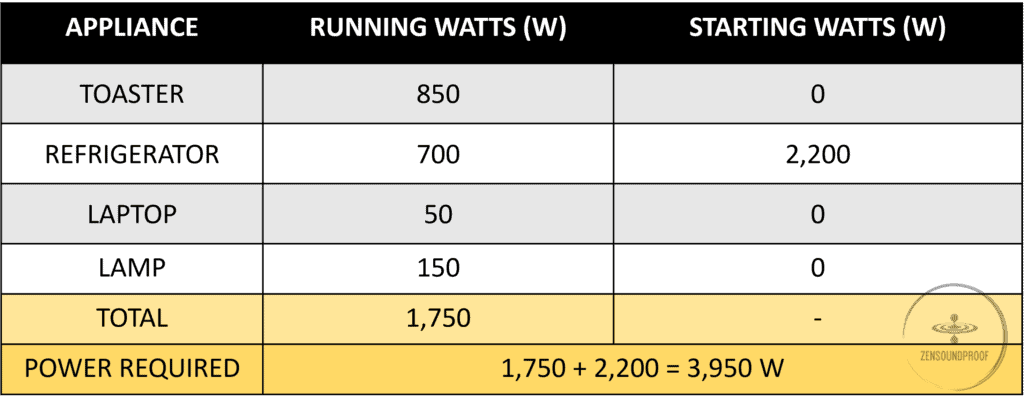
Based on this table, we can see that a 4000 watt inverter generator would be just enough to power all these devices at once. You add the highest starting wattage to the running watts because this is the total (highest) power demand of your setup.
So, to work out whether a 4000 watt generator would be suitable for your needs, you must first add up the running and starting watts of everything you want to power at once. These figures are usually stated on devices, but you can refer to this listing of wattage for some estimates.
How Loud is a 4000W Generator?
A 4000 watt generator can produce anywhere from 50dB to 75dB of noise depending on design and power demands. This is a fairly big range – it’s the difference between a standard conversation and a truck passing you on a road. And when you’re camping, the last thing you want is the noise of a truck going off next to your tent!
Bear in mind that the standard noise rating for generators is performed from 23 ft away. Also, manufacturers perform those noise measurements in ideal lab conditions. This means that if you measure noise in your backyard, you’d have different dB levels because of the ambient noise.
We’ll use this information to inform our picks for the quietest generators. Of course, noise isn’t the only factor to consider but it’s certainly one of the most important.
Our Top 6 Picks
Below are my top picks for the best 4000 watt generator. There’s some flexibility in the wattage, as some provide more than 4000 as their starting watts. However, they all fit into the bracket of 4000 watt inverter generators.
Top Pick: Westinghouse iGen4500 Super Quiet Generator
- Noise level: 52 dB min
- Starting Power: 4500 W
- Running Power: 3700 W
- Inverter: Yes
- Start: Electric & Recoil
- Dual fuel: No (in option)
- Run time: 18 hours (25% load)
- Tank capacity: 3.4 gal
- Outlet / Port:
1 x 120V 5-20R [20A] – (Household type)
1 x 120V TT-30R [30A] – (RV type)
2 x USB
- Wheels: Yes
- Handle: Yes (Not extendable)
- Weight: 98 lbs.
The Westinghouse iGen4500 is my top pick for a quiet generator because it has a noise output of 52dB from 23ft. It’s rated at 3700W running power and 4500W starting power, which is fairly standard. Importantly, it can run up to 18 hours off a 3.4-gallon fuel tank if set to economy mode.
52 dB is an excellent noise rating but can only be achieved in perfect lab conditions. If you measure the noise from your yard close to the road, you’d likely have a higher noise rating, 60-ish dB, as shown in the excellent video from Johnny’s Weekends below. This is due to the ambient street noise (often around 40-50 dB).
The video above also compares the iGen4500 with the Predator 3500 noise emission. The Predator is noticeably quieter but is also delivering about 20% less running watts.
The iGen4500 has a digital display for checking fuel level, power output, run time, and more. As such, it allows you to keep track of what you’re using and how long you’ve got left. Although this is a fairly standard feature on modern generators, it’s helpful nonetheless.
Outlets are obviously a useful feature, and this generator has everything you need. There are 2 x USB ports and 2 x 120V standard outlets: a 20A household-type and a 30A RV outlet. This means you can run numerous devices off it at the same time, providing you don’t overload the power, of course.
The iGen4500 also has a dual fuel option, the iGen4500DFc, which retails around 10% more expensive than the base gas-powered model. Bear in mind, you’ll have lower wattage output if you opt to power it with propane.
The only real downside mentioned by users is that it doesn’t work too well in cold weather. While this isn’t the end of the world, you should be able to insulate it using a sound box (more on this below). That said, there probably aren’t many occasions when you’ll be camping in the winter!
- Noise level of 52dB.
- Up to 18 hours run time.
- Electric starter and multiple outlets.
- Doesn’t do well in cold weather.
Top Budget Pick: WEN 56475 4750 Watt Generator
- Noise level: 67 dB min
- Starting Power: 4750 W
- Running Power: 3750 W
- Inverter: No
- Start: Electric & Recoil
- Dual fuel: No
- Run time: 12.4 hours (50% load)
- Tank capacity: 4 gal
- Outlet / port:
2 x 120V 5-20R [20A] – (Household type)
1 x 120V L5-30R [30A]
1 x 120V TT-30R [30A] – (RV type)
- Wheels: Yes
- Handle: Yes (Foldable)
- Weight: 112.5 lbs.
The WEN 56475 is under half the price of the Westinghouse, but this does mean sacrificing quieter operation. Specifically, this generator outputs 67dB of noise, so it’s at the higher end of our scale. But unfortunately, that’s the cost of a budget-friendly option.
However, it’s still not super loud. 67dB is roughly the equivalent to normal office noise, so it shouldn’t be too distracting in louder environments. The running power is 3750 watts, making it marginally more powerful than the Westinghouse.
In the video below you can hear that the user is not using a voice-over for his footage. He’s talking right next to the generator, and his voice is audible. Obviously, the Wen 4750 can’t match an inverter model, but it’s a decent performer considering the price.
At 112.5 lbs, it’s on the heavy end of the scale. It has good portability features such as a foldable handle and wheels to compensate for its weight.
Like other models, it comes with 4 x 120V outlets, including 2 x 20A and 2 x 30A, among which one is an RV-style outlet. While there’s no included USB adapter, this isn’t a massive deal because you can just charge your devices off a multi-plug cable.
Users mention that the generator doesn’t have a 240V or 12V outlet, which can make it difficult to use for things like running a well pump or for charging devices. However, it’s a budget-friendly model, so expect to pay more if you’re looking for these kinds of features.
- Fairly inexpensive generator.
- Standard outlets.
- Comes with a wheel kit to make it more portable.
- Isn’t overloaded with features.
- On the heavy end.
3. WEN 56380i Super Quiet Generator
- Noise level: 57 dB min
- Starting Power: 3800 W
- Running Power: 3400 W
- Inverter: Yes
- Start: Electric & Recoil
- Dual fuel: No
- Run time: 8.5 hours (50% load)
- Tank capacity: 2.2 gal
- Outlet / port:
2 x 120V 5-20R [15A] – (Household type)
1 x 120V TT-30R [30A] – (RV type)
1 x DC 12V
1 x USB
- Wheels: Yes
- Handle: Yes (Not extendable)
- Weight: 99 lbs.
The WEN 56380i Was another contender for the top pick for best generator. The main reason it didn’t win is that its running wattage is only 3400, and its peak is 3800. As such, it’s noticeably weaker than even the budget WEN model. That said, it’s a direct competitor of picks 4 and 6, but with a lower noise output.
At 57dB on eco mode, it’s the second quietest generator on this list. The video below shows a measurement of 60-62 dB at 23 ft. away. While very comparable to the iGen4500, the Wen’s measurement is performed with lower ambient noise (i.e. in a backyard for the Wen versus next to the road for the iGen4500).
Overall, the WEN 56380i is slightly louder, but not by much.
It’s got an eco-mode for maximum fuel efficiency, and a digital meter so you can monitor voltage, runtime, and more. In terms of functionality, it’s a pretty decent generator.
It’s got all the ports you could need, including 2 x 120V, 1 x 30A DC, a 12V and a 5V. Unlike others on this list, the 120V AC outlets are only rated to 15A rather than 20A. This isn’t a massive downside, but you’ll need to be more careful about what you choose to plug into it.
Some users mention its size and weight as downsides. At 99lbs., it’s pretty heavy for the level of power it outputs. However, it comes with built-in wheels, so it’s at least a bit easier to transport than some generators that only come with a handle.
- Quiet operation – 57dB.
- Eco mode gives you up to 14 hours of runtime.
- Digital screen helps you monitor stats.
- Quite bulky for its power level.
- Small tank capacity.
4. Champion 200986 4500 Watt Portable Inverter Generator
- Noise level: 61 dB min
- Starting Power: 4500 W
- Running Power: 3500 W
- Inverter: Yes
- Start: Electric & Recoil
- Dual fuel: No (In option)
- Run time: 14 hours (25% load)
- Tank capacity: 2.3 gal
- Outlet / port:
2 x 120V 5-20R [20A] – (Household type)
1 x 120V TT-30R [30A] – (RV type)
1 x DC 12V (Car-style outlet)
1 x USB adapter for the car outlet
- Wheels: Yes
- Handle: Yes (Not extendable)
- Weight: 90 lbs.
The Champion 200987 has an operating noise level of 61dB, putting it firmly in the middle of our acceptable noise range. While it’s around 10dB louder than the Westinghouse, it shouldn’t be super distracting for running outside an RV.
It has a 2.3-gallon fuel tank, which equates to 14 hours of run time. The generator has a simple startup dial, which is electric, and you simply press to turn it on. It comes with a remote to start the unit from up to 80 ft. away. As such, it’s one of the easiest generators to operate. Like the Westinghouse, it has an eco-mode that monitors fuel consumption.
The running wattage is 3500, so is slightly lower than the Westinghouse. Its starting power is the same, though. In terms of outlets, you get a 30A RV, 2 x 120V outlets, and an USB adapter. However, there’s also a 12V car-style outlet, which you can use with the USB adapter or anything that would plug into your car.
Some users claim the generator doesn’t output the 30A it claims. While this might be a fault, you can solve it using the parallel-ready installation feature. In short, this means you can hook this generator up to another Champion one in parallel to increase your power output.
I appreciate it has different variants with the same power and noise output for all budgets. There’s a cheaper variant with a manual start only and a more expensive model with dual fuel. One downside of the dual fuel model is it struggles to start on propane. One solution a user found was to help feed the propane by pulling the recoil cord a few times.
- Fairly quiet operation.
- Can start remotely.
- Extra 12V car-style outlet.
- Several choices for all budget type.
- May not output 30A power.
- (Dual fuel model) Struggle to start with propane.
5. DuroMax DS4850EH Dual Fuel Portable Generator
- Noise level: 69 dB min
- Starting Power: 4850 W
- Running Power: 3850 W
- Inverter: No
- Start: Electric & Recoil
- Dual fuel: Yes
- Run time:
On gasoline, 23 hours (25% load)
On propane, 18 hours (25% load) - Tank capacity: 3.9 gal
- Outlet / port:
2 x 120V 5-20R [20A] – (Household type)
1 x 120/240V L14-30R [30A]
1 x DC 12V
- Wheels: Yes
- Handle: Yes (Foldable)
- Weight: 122 lbs.
At 69dB, the DuroMax DS4850EH is about as loud as we’ll want to go for portable generators. However, it’s the most powerful generator on this list with a running wattage of 3850. Although it’s only an extra 150W, this could make a big difference in an RV or tailgate setting.
Importantly, it has both 120V and 240V settings, which other generators lack. It means you can run more energy-intensive appliances, such as a water pump or AC unit. Considering it’s not a feature you find everywhere, it could be worth sacrificing a bit of quietness.
You can run the generator on either propane or gasoline, which is another handy feature. The gas tank is 3.9 gallons or you can hook it up to a propane bottle. The latter is handy if it’s your home’s backup generator, as propane can be stored forever.
It comes with 2 x 120V, 1 x 120/240V outlet, and a DC 12V post. No USB port. This is understandable on a budget-friendly model but a bit of a shame on a high-end generator such as this. However, it’s not the end of the world, as you can still run plenty of appliances off it.
- Has a 240V outlet.
- Runs on either propane or gasoline.
- Highest running wattage on this list.
- May not output 30A power.
- No USB port.
- Very heavy.
6. WEN DF400i Super Quiet 4000 Watt Generator
- Noise level: 58 dB min
- Starting Power: 4000/3200 W (gas/propane)
- Running Power: 3200/2900 W (gas/propane)
- Inverter: Yes
- Start: Electric & Recoil
- Dual fuel: Yes
- Run time:
On gasoline, 8.5 hours (50% load)
On propane, 20lb. tank, 9 hours (50% load) - Tank capacity: 2.2 gal
- Outlet / port:
2 x 120V 5-20R [20A] – (Household type)
1 x 120V TT-30R [30A] – (RV type)
1 x DC 12V
2 x USB 5V
- Wheels: Yes
- Handle: Yes (Not foldable)
- Weight: 100 lbs.
The WEN DF400i has an operating noise level of 58dB, making it the second-quietest on this list. Although louder than the Westinghouse, it has several features that put it in the running for the top pick.
For starters, like the DuroMax, it’s dual fuel. Its running wattage on gasoline is 3200W but only 2900W on propane, though. So, the dual fuel option might be handy, but it won’t net you as much power output as the Westinghouse.
It’s got 2 x 120V, 1 x 30A RV, a 12V DC and 2 x 5V USB outlets. As such, it’s a bit more flexible than the Westinghouse, but obviously you won’t be able to run as many appliances off it anyway. There’s also a surge protector and automatic shutoff in case of low fuel, which keeps your devices and generator safe from damage.
In terms of downsides, this generator has a fairly small fuel tank capacity. At 2.2 gallons, it’s the smallest on this list and equates to around 8.5 hours of half-load run time. Of course, this might be suitable for some but, if not, simply pick one of the larger generators from above.
Second downside is its 30A output which is is only rated at 26 Amps in its specification sheet. It might be troublesome when powering some devices, so keep an eye out for it.
- Noise level of 58dB.
- Dual fuel input compensate for the small gas tank.
- Plenty of outlets.
- Smallest fuel tank on this list.
- 30 Amps rating is on the weaker side.
What to Consider before Buying
While noise level is obviously our main concern here, there are plenty more factors to consider. Below are what you should think about when picking the best generator for your needs.
Power Output
There’s not much else to say about power output that wasn’t covered at the beginning of this article. Check if a 4000W generator is suitable. If not, I’ve sorted the quietest generators by power output at:
I’ve summarized all my findings in this other article, where I give you my best picks by use case scenario (i.e., for camping, for a home backup, etc.)
Runtime
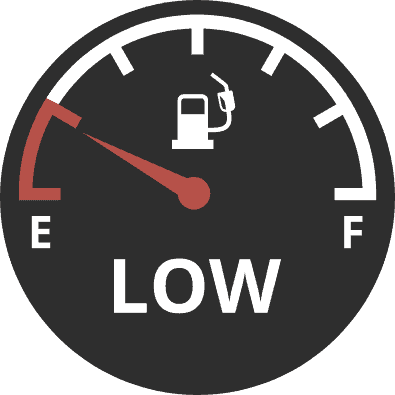
All generators will state their runtime, but this is often stated for the generator’s half load. This means how long the generator will run on a full tank if it’s only using half its maximum load. For a 4000 watt generator, this would be 2000 watts.
The most suitable runtime will depend on your needs. For example, a generator for camping or for use with an RV will want a much longer runtime than one for powering tools at a jobsite.
However, a longer runtime always means you need to refuel it less often, making it useful regardless.
Fuel Source
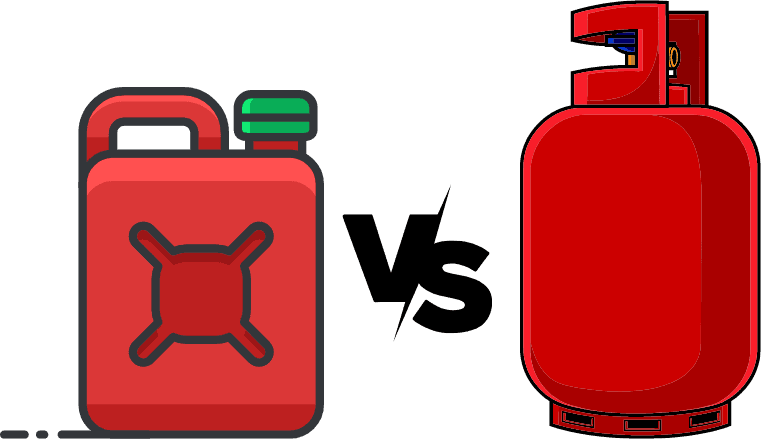
Typically, a generator is powered by standard gasoline. It’s the same stuff you put in your car, making it easy to get hold of. A generator’s fuel tank could be anywhere from 2 to 4 gallons for a 4000W, and this is proportional to its runtime.
Some generators are dual fuel, meaning you can hook them up to a propane tank. While they often have lower power from this fuel source, the runtime is typically much longer because a propane tank is bigger.
Propane is a useful backup if you’re using the generator to power your home or an RV, as it can be stored indefinitely. Of course, this isn’t as helpful when camping because you probably won’t want to carry a massive propane tank with you everywhere.
Inverter Generators vs. Conventional Generators
All the picks above are inverter generators rather than conventional ones. While these aren’t specifically the norm, they’re becoming more popular thanks to how they work and the kind of power they provide.
The biggest difference between the two is that an inverter generator uses an electric throttle to adjust to power demands. It means it could run on half load, for example, if there aren’t too many devices plugged in. A conventional generator can only run on full power all the time.
Check the video below if you’re curious about how an inverter modulates the voltage signal from a DC source. It details what Pulse Width Modulation is and how it outputs the desired signal.
Another key feature is that advanced inverter technology produces clean power. By this, I mean that the generator is able to maintain a constant RPM, which reduces Total Harmonic Distortion (often referred to as THD in manufacturers’ specs). This means the voltage and frequency don’t fluctuate, producing better power for sensitive electronics.
Inverter generators produce DC power, which a conventional generator can’t. Finally, they’re typically more fuel efficient and, by extension, quieter. You’ll notice in the list of generators above that all inverter units have lower dB ratings.
Electric Start
All the generators listed above have electric starters. In short, this means the ignition is battery-powered (like on cars). For generators, there are 2 ways an electric starter can work:
- A button. This is pretty simple: you press a button to fire up the generator’s motor.
- A recoil cord. The generator will have an electric starter still, but you then pull a cord to manually start the engine.
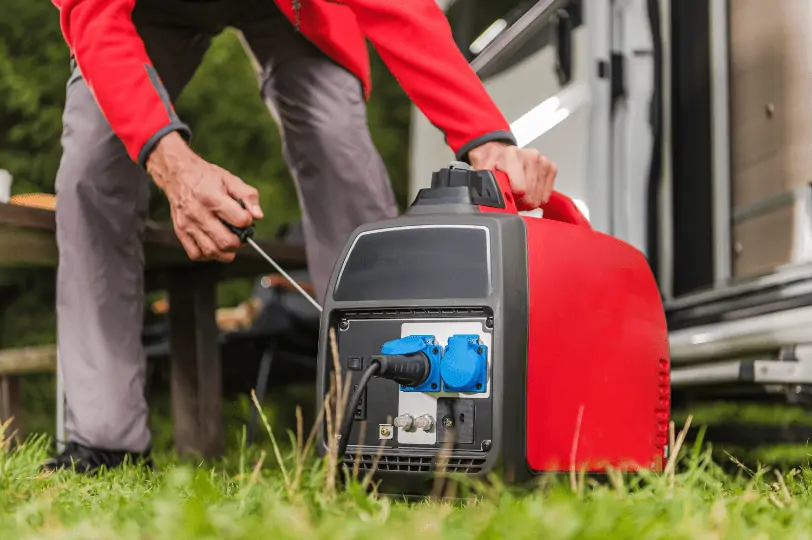
An electric button ignition is obviously much easier to manage. Generators will recharge their ignition battery through normal operation, but there’s still a chance the battery can die if you don’t use it for a while.
If this is a concern, look for generators with some kind of manual start. This will usually be a simple recoil cord without an electric button.
Noise Level
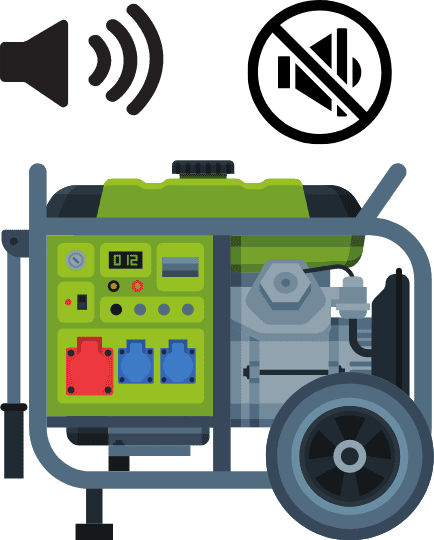
Again, there’s not much else to say here that isn’t mentioned above. You’ll want a quieter generator for camping than you would for a jobsite, while using it for an RV will sit somewhere in the middle.
If you can’t find a generator that’s quiet enough in your price range – or you need to quieten a loud generator – consider checking out my article on how to make a generator quiet.
Outlets

One of the most important factors in a generator is the number (and types) of electrical outlets. A standard generator will usually have the following:
- 120V – 20A alternating current (AC) outlets. These are suitable for most household appliances, such as refrigerators, TVs, toasters, etc. Their technical designation is Nema 5-20R.
- 120V – 30A outlet. You’d use this in your RV for something like an AC unit that draws more power than typical appliances. Their technical designation is TT-30R.
- 120/240V – 30A outlet. This works for power hungry devices. You’d find these outlet under the reference L14-30R.
- 12V direct current (DC) outlet. You’d use this for anything you could run off a car or RV battery, such as your RV water pump, camping refrigerators, etc.
- 5V DC outlet for charging phones, tablets, etc.
Some 4000W generators can supply 240V power as well as 120V. This is for more demanding devices like an AC unit, electric kettle, or water pump. It’s not always necessary for camping or use in an RV, but would be helpful if you’re buying the generator as backup power for your home.
There’s not much to say regarding what devices you can run using these outlets. It should be fairly obvious based on the device’s information when you buy it. Generally, it should be clear whether something needs 120V or 240V power or an AC or DC connection.
Think about what you need to power and when, and this should help you decide on how many outlets you need. A standard generator will have 2 x 120V, 20A outlets. You can plug an extension cable into these, but just be wary of the power draw in amps from everything you hook up to it.
Portability
As a general rule, most 4000W generators will be portable in the most literal sense. Compared to something like a 10,000W generator, they’re fairly small and compact. Their weight, however, can vary quite a lot. Expect it to weigh between 80 and 100lbs. as standard.
Some come with wheel kits, which obviously make them more portable. This is useful in almost all scenarios, as you’ll have to carry or drag it otherwise. Failing that, you could buy a wheel kit for your generator (such as this kit from WEN) or check out this video for a rough guide on how to make one.
It’s worth noting, though, that installing a wheel kit might make a difference to the noise output. After all, it gives you one more thing to rattle on your generator (especially if the wheels are made of hard plastic), and you might not be able to dampen the generator’s noise as easily compared to it sitting directly on the ground.
Warranty
Finally, make sure you think about a warranty. Generators aren’t cheap and you’ll want some kind of protection in case it breaks down. 3-year warranties are fairly standard, but most companies will offer an extended warranty if needed.
Final Thoughts
I hope you’ve now got enough information to pick out the best 4000 watt generator for your needs.
My top pick is the Westinghouse iGen4500 Super Quiet Generator. At only 52dB, it’s super quiet and doesn’t sacrifice many features to reach this noise level. Of course, if you do need extra outlets or 240V power, the other options on this list will be great.
Have you picked out a quiet 4000W generator before? If so, I’d love to hear from you below if you’ve got any other advice for making the right selection.






